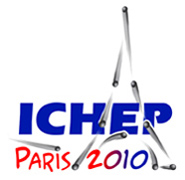Speaker
Paolo Gauzzi
(Universita di Roma I "La Sapienza")
Description
KLOE results on light meson spectroscopy
The KLOE experiment has collected 2.5 fb-1 at the peak of the phi resonance at the e+e- collider DAPHNE in Frascati. The whole data set includes 100 million eta's produced through the radiative decay phi --> eta gamma and tagged by means of the monochromatic recoil photon. With this sample, we are studying eta rare decays. We have a final result for the BR measurement
of the eta --> pi+pi-e+e- decay, with a sample of 1600 signal events, 100 times larger than today best measurement. These events are also used to measure the asymmetry between the pi+pi- and the e+e- decay planes in the eta rest frame, whose observation could test unexpected mechanism of CP violation, thus providing an hint of new physics beyond the Standard Model. The same data set has been also used to extract the BR for the never observed before eta --> e+ e- e+ e- decay channel. We have studied the dynamics of the eta --> pi0 pi0 pi0 decay using the Dalitz plot technique, obtaining a new determination of the quadratic slope. The result is consistent with the present world data and with current chiral perturbation theory calculations within the unitary approach. In the eta --> pi+ pi- gamma decay a significant contribution from chiral anomaly is expected. The distribution of the invariant mass of the pions allows to disentangle this contribution from resonant intermediate processes. Old measurements from the '70s with data samples of the order of 10^4 events provided contradicting results. KLOE data contains about 3.5 x 10^6 eta --> pi+ pi- gamma decays. With this statistics it is possible to investigate in detail the pion invariant mass distribution and to search for C violation signature in the left-right charge asymmetry. Currently we have used 1.2 fb-1 to perform a preliminary measurement of the branching ratio and to tune the analysis for the study of the pi+ pi- invariant mass. From a sample of 240 pb-1 taken off the phi resonance, a preliminary analysis of the e+ e- --> e+ e- eta process, without tagging e+e- in the final state and identified through the eta --> pi+ pi- pi0 channel, is presented. The same data set has been used to search for the f0(600) that can be produced in gamma-gamma interactions and observed in the reaction e+ e- --> e+ e- pi0 pi0.
The preliminary pi0pi0 mass spectrum show an excess of events with respect to the expected background in the f0(600) mass region. From the process e+ e- --> pi+ pi- gamma it is possible to test scalar meson contribution using the interference among final state radiation, scalar and vector meson exchanges. This interference produces a forward backward asymmetry as a function of the pi+pi- invariant mass. Preliminary results are presented both for on-peak and off-peak data, showing a good agreement
with MC expectations containing scalar and VMD contributions extracted from KLOE data.
KLOE Measurement of sigma_pi^+pi^-(gamma) with ISR and pi-pi contribution to the muon anomaly
The KLOE experiment, operating at the Frascati φ-factory DAφNE, has measured the differential cross section for the process $e^+e^- --> pi^+pi^-gamma as a function of the pi^+pi^- invariant mass, M_pi-pi, using two different configurations: (a) a non-observed photon, emitted at small angle (SA), whose energy is obtained by kinematics; (b) a photon emitted at large angle and detected in the calorimeter (LA) where its energy is measured. With the two samples the M^2_pi-pi range 0.1 < M^2_{pi-pi} < 0.95 GeV^2 is covered. The measurement of the pi^+pi^- cross section at SA, normalized to the integrated luminosity has been published recently. We present the final results of a new independent measurement at LA using data taken in 2006 at a collision energy of 1 GeV, 20 MeV below the φ-peak. We will discuss also the impact of these measurement on the evaluation of the hadronic contribution to the muon anomaly, and the results on the exctraction of the pion form factor from the ratio of sigma(e^+e^- --> pi^+pi^-gamma) to sigma(e^+e^--> mu^+mu^-\gamma).
Hadron Physics with KLOE-2
Experiments at the Phi-factory can shed light on many aspects of hadron physics. A new beam crossing scheme allowing for a reduced beam size and increased luminosity is operating at DAφNE. The KLOE-2 detector is successfully rolled in this new interaction region and is ready to acquire collision data. At the moment, the detector is being upgraded with small angle tagging devices, to detect both high and low e^+e^- energy in e^+e^- --> e^+e^-X events, namely gamma-gamma processes. The following perspectives are presented: gamma-gamma --> pi^0pi^0 for probing light scalar meson dynamics, and gamma-gamma --> eta, gamma-gamma --> pi^0 for the determination of transition form factors. The inner tracker and small angle calorimeters are scheduled to be installed in a subsequent step, providing with larger acceptance for both charged particles and photons. We present perspectives derived using these upgrades together with increased statistics: rare eta decays, accurate study of the dominant eta' decays (e.g. eta' --> eta pi pi, to constrain scalar meson exchange) and the limit on the phi --> K_S K_S gamma branching ratio, relevant for the scalar meson structure. One possible solution to the Dark Matter problem, allowing also to interpret the positron excess measured by the satellite Payload experiment PAMELA, suggests a Hidden Sector that can be constrained by KLOE-2 at DAφNE: possible channels and impacts on the parameters space are discussed. Improvements on hadronic cross section at an energy-upgraded DAφNE are addressed, needed to understand the 3-sigma effect on (g-2)_mu and for precision determination of alpha_em at the TeV scale.




